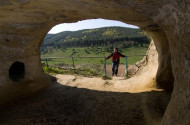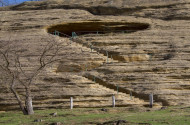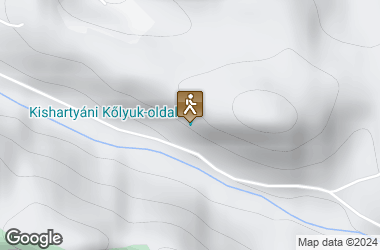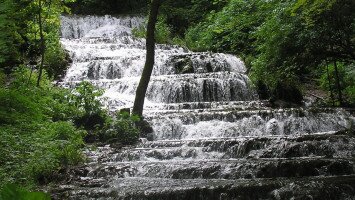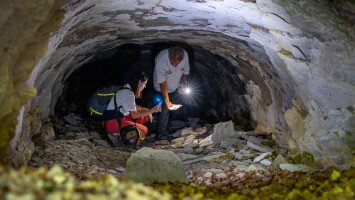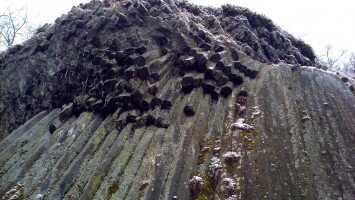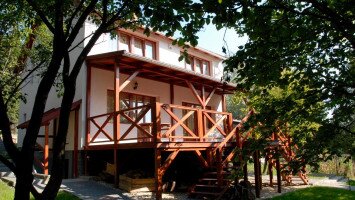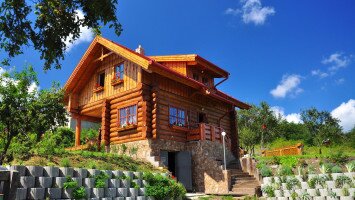Fekvése, megközelítése
Kishartyánban a kultúrház előtt térjünk le a 22-es útról Nógrádmegyer felé. 1 km után község szélén álló templomnál, a temető déli oldalán vezető bekötőúton a Kővölgyben folytassuk utunkat. A termelőszövetkezeti major portalanított útja vezet el a védett Kőlyuk-oldalhoz.
Keletkezése
A 13 hektár kiterjedésű védett területen szép feltárulásban láthatjuk az oligocén tenger üledékét. A mintegy 30 millió évvel ezelőtti tenger parti sávjában halmozódott fel a néhol különleges formát mutató sárgásbarna, nagy kvarc tartalmú, homokkő. A kőzet alsó része keményebb, sötét színű, még a felső egyharmada világosabb és lazább szerkezetű, benne kavicsos rétegek is vannak. Ebben a világos színű rétegben cápafogakat is találtak.
A megközelítően 300 méter hosszú és mintegy 30-40 m magas kőzetfal legmeredekebb részén, valószínűleg egy lazább üledék kimosásával, természetes üreg keletkezett, melyet mesterségesen mélyítettek tovább. A tatár- és törökdúlás idején menedékhelyül szolgált a helyieknek, valamint a XIX. század végéig remeteéletet élő szerzetesek is lakták az üregeket.
Felszínalaktani jellemzők
A barlang több helységből áll: egy 6x5 m alapterületű nyitott előtérből, amely nappali tartózkodási hely, tűzrakó-és tüzelőtároló hely volt; egy 6 m hosszú, 2 m széles és 2 m magas teremből, amely éjszakai pihenőhelyként szolgált és ablakkal is rendelkezett; valamint egy 5 m hosszú és mintegy 1,5 m magas kisebb üregből, amely élelmiszer és ivóvíz tárolására szolgálhatott. A barlangot a kőfalon mélyített lépcsőkön lehetett elérni és a csúcs irányába lehetett elhagyni egy kapaszkodókkal ellátott feljárón keresztül.
Növény-és állatvilága
A geológiai látványossága mellett a terület néhány védett növény- és állatfajjal is büszkélkedhet. Védett növények közül megtalálható itt a fekete kökörcsin (Pulsatilla pratensis subsp. nigricans) és említést érdemel a kakukkfű (Thymus spp.) is, mert egyedein az európai jelentőségű nagyfoltú hangyaboglárka (Maculinea arion) állománya él. A szitakötők közül előfordul itt a lápi acsa (Anaciaeschna isosceles) és a berni egyezményes, a kipusztulás szélén álló, piros szitakötő (Leucorrhinia pectoralis) is. Lepkék közül nagy számban találkozhatunk a kis színjátszólepkével (Apatura ilia), valamint a nagy rókalepkével (Nymphalis polychloros). A bogarak közül a szarvasbogár (Lucanus cervus) néhány példányát is megfigyelhetjük. Madarak közül említést érdemel a tövisszúró gébics (Lanius collurio), hangját hallatja a sárgarigó (Oriolus oriolus) és a kakukk (Cuculus canorus). A macskabagoly (Strix aluco) az idős, odvas fákat keresi. Az égen gyakran látjuk körözni az egerészölyvet (Buteo buteo), amely rágcsáló, hüllő, kétéltű vagy rovar zsákmányára vadászik. A homokköves oldal aljában jelenleg állattartó telep működik. A tereprendezés következtében kialakult mesterséges homokfalba 1 pár fokozottan védett gyurgyalag (Merops apiaster) is fészkel. A napsütötte homokkőfalakat előszeretettel keresi fel a zöld gyík (Lacerta viridis) és a fürge gyík (Lacerta agilis).
Az oligocén kori homokkő meglehetősen egységes flórája és vegetációja elsősorban azokon az élőhelyeken tűnik szembe, ahol az alapkőzet a felszínre bukkan, illetve csak sekély talajréteg borítja (sziklagyepek, lejtősztyeppek, bokorerdők, szurdokerdők). A Kőlyuk-oldal oligocén homokkövén megtalálható a fali kövirózsa (Sempervivum tectorum)– feltehetően kivadult – jól fejlett, dúsan virágzó tövei. A sziklafal alsó szegélyében a sárga iglice (Ononis pusilla) és néhány tő cicó (Thymelaea passerina) is előfordul. A homokkőszikla alatti laposabb, homokos részeken és nyílt gyepekben megtalálható a homoki habszegfű (Silene conica). A homokkőfalakon pionír, ritka gomolyos kőhúr (Minuartia glomerata) kis egyedszámban van jelen. A meszes homokkőmálladékon a pézsmahagyma (Allium moschatum), a bunkós hagyma (Allium sphaerocephalon) és a deres fényperje (Koeleria glauca); valamint a lejtősztyeppekben, felhagyott legelőrészeken a kunkorgó árvalányhaj (Stipa capillata) egyedeivel találkozhatunk.

